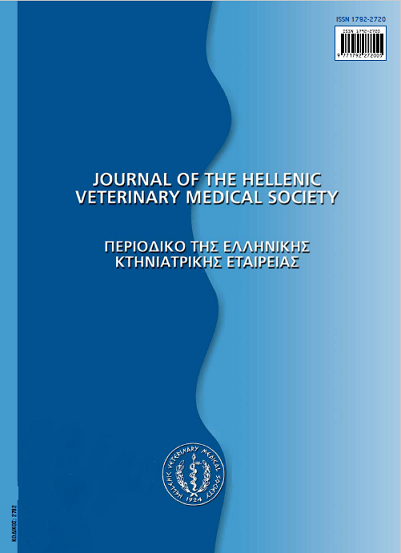Sensitivity of preputial and vaginal exfoliative cytological examination for diagnosis of canine leishmaniosis (Leishmania infantum)
Abstract
Aim of the study was to examine sensitivity of preputial and vaginal exfoliative cytological examination as a noninvasive alternative to lymph node, spleen and bone marrow cytology, for detection of Leishmania infantum amastigotes in dogs with leishmaniosis, as, in previous studies, the protozoa have been observed in the penis and prepuce of male dogs and in the vagina of female dogs with leishmaniosis. In total, 20 male and 18 female dogs with confirmed leishmaniosis were included in
the study. Three cytology smears were prepared from different sites of the preputial cavity of males and one smear was prepared from the anterior vagina of females. Leishmania amastigotes were not observed in these samples after microscopic examination for 20 min at 1,000× magnification. Therefore, preputial and vaginal exfoliative cytology is not recommended for routine diagnosis of canine leishmaniosis.
Article Details
- Come citare
-
ATHANASIOU (Λ.Β. ΑΘΑΝΑΣΙΟΥ) L. V., CHATZIS (Μ.Κ. ΧΑΤΖΗΣ) M. K., GOULETSOU (Π.Γ. ΓKΟΥΛΕΤΣΟΥ) P. G., & SARIDOMICHELAKIS (Μ.Ν. ΣΑΡΙΔΟΜΙΧΕΛΑΚΗΣ) M. N. (2017). Sensitivity of preputial and vaginal exfoliative cytological examination for diagnosis of canine leishmaniosis (Leishmania infantum). Journal of the Hellenic Veterinary Medical Society, 65(1), 31–34. https://doi.org/10.12681/jhvms.15510
- Fascicolo
- V. 65 N. 1 (2014)
- Sezione
- Research Articles
Authors who publish with this journal agree to the following terms:
· Authors retain copyright and grant the journal right of first publication with the work simultaneously licensed under a Creative Commons Attribution Non-Commercial License that allows others to share the work with an acknowledgement of the work's authorship and initial publication in this journal.
· Authors are able to enter into separate, additional contractual arrangements for the non-exclusive distribution of the journal's published version of the work (e.g. post it to an institutional repository or publish it in a book), with an acknowledgement of its initial publication in this journal.
· Authors are permitted and encouraged to post their work online (preferably in institutional repositories or on their website) prior to and during the submission process, as it can lead to productive exchanges, as well as earlier and greater citation of published work.












